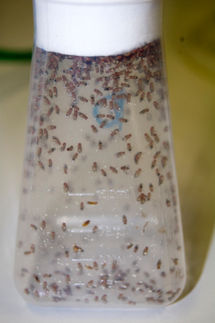New research indicates that DNA sequence itself influences mutation rate
Genetic variation due to DNA mutation is a driving force of adaptation and evolution, as well as a contributing factor to disease. However, the mechanisms governing DNA mutation rate are not well understood. In a report published in Genome Research, researchers have identified intrinsic properties of DNA that influence mutation rate, shedding light on mechanisms involved in genome maintenance and potentially disease.
Some DNA mutations are subject to natural selection, either conferring a biological advantage that is selected for, or a negative effect that is selected against. Mutations not under selection are said to be neutral, and the rate at which neutral mutations accumulate is reflective of the true DNA mutation rate. Researchers can estimate this mutation rate by comparing neutrally evolving sequences in species that share a common ancestor.
Interestingly, the neutral mutation rate can vary significantly between different regions of chromosomes. This suggests that the context of the DNA influences how rapidly it accumulates mutations. Sequence high in pairs of the bases C and G (CpGs) where the C’s are chemically modified, have been positively correlated with mutation rate. However, the chemical modification of CpGs makes them prone to mutation themselves, and with time they are eliminated from neutrally evolving sequences. NIH researchers Jean-Claude Walser and Anthony Furano have taken advantage of this property to investigate the role of CpGs on the mutation rate of non-CpG DNA, by comparing “old” and “young” sequences.
Walser and Furano compared the CpG content and DNA changes in inactive L1 retrotransposons shared by humans and chimpanzees. These ancient DNA sequences that had previously expanded in our common ancestor to multiple copies interspersed throughout the genome, but are now extinct “DNA fossils” that are neutrally evolving.
The researchers had previously noted that the older L1s have a lower CpG content than the younger sequences as expected, but here they observed two particularly striking features: “The overall mutation rate in the older fossil sequences dropped dramatically,” said Furano, indicating a certain CpG content threshold is required to affect the non-CpG mutation rate. “And most provocatively, the types of mutations changed significantly.”
This means that CpGs are not only promoting mutations, but they are also influencing how the non-CpG sequences around them are being mutated, an extension of what the authors call the “CpG effect.” These findings strongly support the hypothesis that the co-variation of CpG content and non-CpG mutation rate is a property of the DNA sequence itself, and not a result of the chromosomal location.
“Intriguingly, the CpG effect revealed by our studies mimics the altered mutational state that has been demonstrated for certain cancers,” Furano noted. Furthermore, the authors expect that this work will open the door to future studies investigating the mechanisms by which CpGs exert their influence on mutation rate and how this is involved in the critical process of genome maintenance.
Scientists from National Institute of Diabetes and Digestive and Kidney Diseases (NIDDK) contributed to this study.
Original publication: Walser J, Furano A.; "The mutational spectrum of non-CpG DNA varies with CpG content." Genome Res 2010.
Most read news
Topics
Organizations
Other news from the department science

Get the life science industry in your inbox
By submitting this form you agree that LUMITOS AG will send you the newsletter(s) selected above by email. Your data will not be passed on to third parties. Your data will be stored and processed in accordance with our data protection regulations. LUMITOS may contact you by email for the purpose of advertising or market and opinion surveys. You can revoke your consent at any time without giving reasons to LUMITOS AG, Ernst-Augustin-Str. 2, 12489 Berlin, Germany or by e-mail at revoke@lumitos.com with effect for the future. In addition, each email contains a link to unsubscribe from the corresponding newsletter.






















































